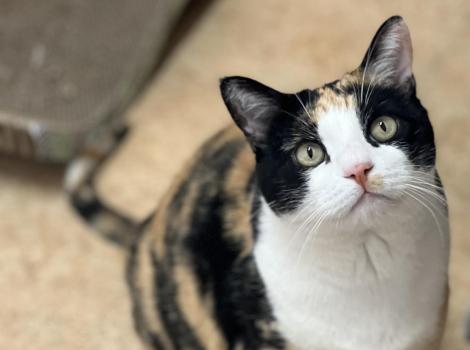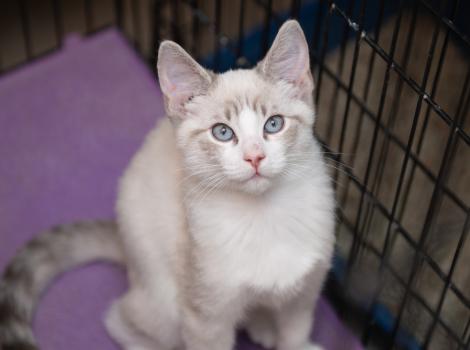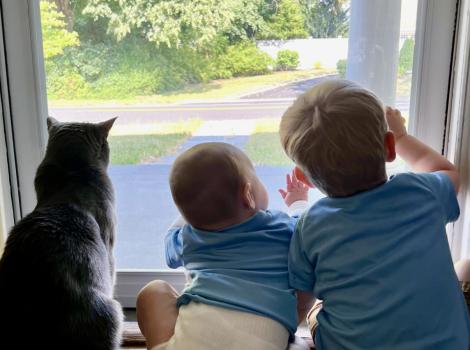Faces of No-Kill: Cat thrives after FIP treatment

The Faces of No-Kill series highlights stories about pets who have become a statistic in the best way. These are just a few of the many pets who once slipped into danger; they lost their homes, they had health or behavioral challenges, their families couldn’t care for them, or all the above. But each one of them got assistance, and today they are thriving thanks to an animal shelter program that helped them rather than killed them. Best Friends’ goal is for every animal shelter and every community to reach no-kill by 2025. The story below is just one example of why it’s so important.
Dixon’s days are delightfully domestic. The 1-year-old tabby cat follows a typical feline routine, splitting her time between raucous wrestling matches and sleepy snuggles with her furry (and not-so-furry) family. And when she’s not busy playing, napping, or having her coat meticulously groomed by a friend’s sandpapery tongue, she’s like a little shadow, following her person from room to room. All fairly standard feline affairs.
What makes this incredible is that Dixon is here to enjoy life at all; she’s had to beat the odds many times over for it.
The most serious hurdle she’s had to overcome in her young life is feline infectious peritonitis (FIP), a disease in cats caused by a coronavirus. A disease that, until recently, had no effective treatment available to U.S. veterinarians and was 100% fatal.
But things are changing, due in part to a recent clinical trial on two antiviral drugs at the University of California, Davis (UC Davis). And Dixon got to be part of making that change.

Kittens’ uphill battle for survival
In her earliest days, Dixon could have become a statistic simply for being a tiny kitten in a full shelter. But luckily, she’d landed at a Best Friends Network Partner and soon caught a ride with around 200 other cats to Best Friends Animal Sanctuary. That’s one of the most important ways that shelters across the country have reached no-kill — by working together to save pets who need extra care or time. And Dixon needed a whole lot of both.
When she and her siblings were diagnosed with panleukopenia (also known as feline distemper), they spent time in the clinic so veterinary staff could keep a close eye on them and administer treatment. It was difficult, and sadly Dixon lost two littermates. But with help she made it through — only then to develop FIP.
In the past, there would have been nothing veterinarians could do to save her. But studies led by emeritus professor Dr. Neils Pederson at UC Davis discovered that FIP is treatable with antiviral therapy. Now, under the leadership of Drs. Brian Murphy and Krystle Reagan, clinical trials investigating FIP treatment drugs at UC Davis were underway, and if Dixon could join the study, it may save her life.

A road trip to recovery
Since the clinical trials were just that — research that would be studied, reviewed, and published — there were some requirements for which cats could participate. Cats of any age were welcomed, though researchers were careful to pick felines without other health factors that might affect the study. And they had to have the “wet” form of FIP, as that was the focus of the trials. Cats with wet FIP have an accumulation of fluid in their abdomen, causing a swollen belly, or in their chest, leading to difficulty breathing as the fluid puts pressure on the lungs. So little Dixon, with her bloated belly, was a fitting candidate.
When Dixon’s application was approved, there was a flurry of activity. She needed to start treatment right away. “It was like, OK, she can go; they have time to see her on this day. We need to get her there,” recalls Amy Kohlbecker, director of Cat World at the Sanctuary. And with the kitten’s life hanging in the balance, there wasn’t much time to figure out who would be taking her from southern Utah to California and how. Amy carefully tucked Dixon into a big carrier, loaded her into a Best Friends van, threw together a small travel bag, and hit the road.
[Embed program helps California kitten rescue expand fundraising]
“I put her right where I could constantly check in on her because she wasn't eating at this point and I wanted to be able to monitor her closely during the long drive,” Amy says. “And I just drove as far as I could until I couldn't drive anymore. I spent the night with her, somewhere in California, and then got up and drove to UC Davis where she was seen the next morning.”
The morning was a blur of tests and making sure everything was recorded and ready to go. And then, it was time for Amy and Dixon to turn around and get back to the Sanctuary. The UC Davis team sent along the medicine plus a daily logbook to record the doses given and to note any significant changes in the patient.
With all the activity, Dixon was extra quiet on the return trip, hiding under the bed at a hotel and not coming out for cuddles like she had the nights before. But it wasn’t long before she started perking right up.
The big turning point
After just five days, Dixon was already starting to improve. Her swollen stomach had shrunk — a sign that the fluid that had filled her abdomen was going away — and her appetite was growing appropriately kitten-sized. “You could tell that she was feeling better,” says Amy. “She was active, more so than she had been the previous few days. So I was hopeful at that point that the medicine was working.”
After their trip together, Amy had taken Dixon home to foster, so she also took point on her treatment and observations for the logbook. Researchers at UC Davis were in constant contact, making sure everything was going smoothly and that Dixon was doing well.
[Faces of No-Kill: Kittens heal from contagious condition]
Of course, like most kittens, Dixon was particularly opinionated when it came time for her very important pill — especially as she started to feel better and have more energy. “It's funny. You're supposed to give the pill at the same time every night. And it was in a pill bottle. And she would know, as much as I tried to disguise it. I'd give everybody wet food, and she'd be eating, and I'd slowly slide over to get her … and she would run in the other direction. She'd hide under the coffee table,” Amy explains, with a laugh. “She was really dramatic about it.”
But even with her attempts to avoid medication, within just two weeks all the fluid in Dixon’s abdomen was gone. She was playing, eating, and enjoying her best kitten life. She was still under close observation and getting her pills. But just like that, the hardest part was behind her. She had survived. And she was getting stronger.

Flying into the future
As Dixon grew in leaps and bounds, the dosage for her medication increased, and she took another trip to California for a mid-trial checkup. She was a practiced paw at road trips, and the long car ride there and back didn’t bother her. And then she sailed through the second half of it.
At Amy’s home, Dixon was out and about with the rest of the household kitties, fitting right in like she’d been there forever. There was Spencer, who indulged her in all-out wrestling matches, while the rest were happy to take over in her calmer moments to snuggle and groom. And every night, Dixon cuddled right up next to Amy (or on top of her, as the mood struck) and fell sound asleep.
So when it was time for Dixon to make her last trip to California — to have her final check-in, turn in the logbook noting her months of medication, and get the all clear — of course Amy wanted to join her. Not only had the tiny tabby worked her way into Amy’s heart, but it was also an exciting moment just to be part of. Things could have gone very differently for little Dixon. Things had gone very differently for countless kittens before her, and Dixon was part of making sure there wouldn’t have to be more after her. It was a big deal.
Such a big deal, in fact, that Dixon was going to be traveling in style. A local volunteer and pilot offered his time and plane to fly Dixon to her last appointment. And while Amy took in the awe-inspiring scenery from above, little Miss Dixon happily napped the flight away right beside her without a care in the world.

Dixon is home
These days, Dixon doesn’t have to worry about sneaking away from the pill bottle. She’s a free feline, busy with important cat things that simply can’t be interrupted. She may not know just how important the whole adventure was, but she seems pretty pleased with where she ended up. Amy made things official and adopted her.
“Knowing how many amazing cats have died from this virus … I mean, I've experienced a ton of them in my lifetime in animal welfare — there was no option. Once a cat was diagnosed, you knew the end was near,” Amy says. “So the fact that there is now this option is really, really amazing. (Dixon) could very easily not be here. That's what I think all the time: This cat who has brought so much joy to my life would not be alive if we didn't have people exploring a cure and finding this medication.”

Let's make every shelter and every community no-kill by 2025
Our goal at Best Friends is to support all animal shelters in the U.S. in reaching no-kill by 2025. No-kill means saving every dog and cat in a shelter who can be saved, accounting for community safety and good quality of life for pets.
Shelter staff can’t do it alone. Saving animals in shelters is everyone’s responsibility, and it takes support and participation from the community. No-kill is possible when we work together thoughtfully, honestly, and collaboratively.






